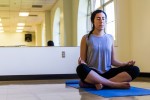Alissa Evans’ experience with stress stems primarily from her inability to definitively choose a major, a recently received D that taints her otherwise mediocre GPA and her complete and utter confusion regarding the abstract concept commonly referred to as her “future.” In the midst of a midcollege crisis, the Daily Bruin columnist decided to try a different stress-relieving activity every other week of winter quarter and chronicled her quest for mental homeostasis in Stress Less.
My perception of modern-day people who laud the powerful effects of meditation involves Greenpeace bumper stickers and fat-free soy milk.
However, after a few earnest attempts at sitting and listening to the sound of my own breathing for 20 minutes, I found myself believing their fervent endorsements.
The practice of meditation traces back to Hindu scriptures written over 3,000 years ago, and has since been incorporated into many other prominent cultures. Multiple studies, including one published in Psychiatry Research, have proven that meditation reduces stress and breaks anxious thought patterns by fostering a mindset less fixated on the past or future and more focused on the present moment. And while the initial prospect of an extended period of time alone with my thoughts was more anxiety-inducing than relieving, the actual act of meditating produced tangible results.
Although I have yet to learn the names of my professors, midterm season is rapidly approaching, which means stress levels are skyrocketing and quadruple shot espressos are in high demand. Initially, meditation did not seem conducive to acing my psychology midterm. My sharp intuition, however, suggested it would be more productive than the alternative: bingeing episodes of Food Network’s “Chopped” and crying.
Because my attention span averages about six seconds, I decided guided meditation videos on YouTube would be a solid place to start. The concept of a trained practitioner telling me exactly what to do a la Cha-Cha Slide felt imperative in honing my feeble concentration skills.
When I was absolutely sure my roommate would not return to the dorm and interrupt my silent paradise, I turned off the lights, climbed into bed and assumed the crisscross applesauce position of an amateur meditator.
Ambient background music flooded my ears as a gentle male voice welcomed me to a safe place and encouraged me to relinquish the day’s stress. Throughout the 20-minute video, I was calmly instructed to relax every part of my body and focus on my breathing.
I inhaled. I exhaled.
Despite my fervent efforts to fight the looming effects of mental exhaustion, the enticing call of sleep became increasingly tempting.
Although I miraculously managed to stay awake, my mind constantly drifted from the rhythm of my breathing to more important topics: how Jack in the Box could profit from 99-cent tacos or the polarizing evolution of Harry Styles’ hair. When I remembered the task at hand and realized I was literally failing at breathing, my first instinct was to accept defeat. But the singsong voice of my meditation instructor and newfound friend encouraged me to embrace the stream of consciousness and to gently reset my concentration after indulging in my scattered thoughts.
After this online session and two similar sessions the following few days, I noticed a shift in the way I viewed both myself and my academic career: The time I accidentally called my teacher “mom” four years ago no longer haunted my every waking moment, and the prospect of midterms seemed more than doable. However, the positive effects were relatively short-lived, likely due to my inconsistent meditation schedule.
In an attempt to survey the many facets of meditation, attending an on-campus group meditation class was next on this week’s stress relief itinerary.
I entered the dimly lit room in the Sunset Canyon Recreation Center only to be immediately made aware of the fact that students were expected to bring their own yoga mats. I noticed a steady trickle of students retrieving foam blocks from a storage closet, and I quickly followed suit, completely oblivious to their function but utterly desperate to fit in.
The class was prefaced by an allegedly easy 25-minute yoga routine that elicited cracks from parts of my body that I did not know were capable of producing those sounds. And despite my inability to touch my toes, I channeled every ounce of my limited flexibility into the pretzel-like positions.
After building up a substantial sweat, the class transitioned into deep relaxation and meditation. I laid on my back with my eyes closed as the instructor’s French lilt caressed my senses, evoking the sensation of floating among the clouds. Although I endeavored to shut out everyone else in the room, I often found myself glancing around to see what others were doing. Despite the instructor’s success at creating an aura of peace and serenity, I felt as though I was surrounded by people with the minds of Yoda and the bodies of Elastigirl, which made it difficult for me to completely let go.
We concluded in the upright position, palms facing the ceiling, chanting “om” in unison, and l left feeling mentally realigned and ready to resume studying.
After allowing sufficient time to reflect, it was evident by my newfound peace of mind that both online and group meditation alleviated my stress levels. That being said, I found it easier to relax during the YouTube guided meditation, in the comfort of my own dorm. Meditation is a profoundly personal experience, and it felt right to venture through the depths of my consciousness completely alone.
